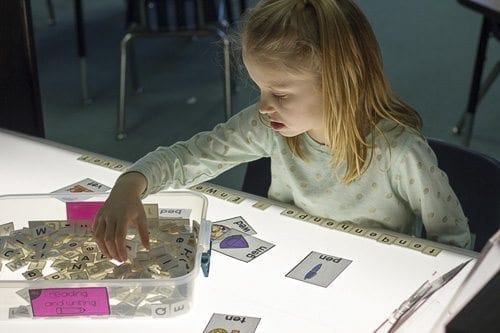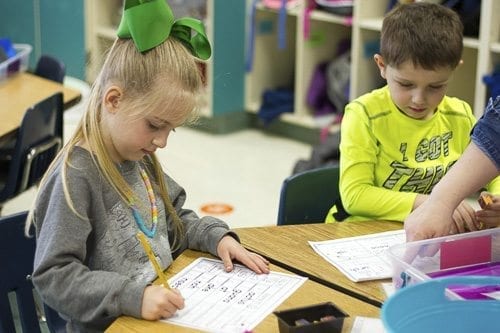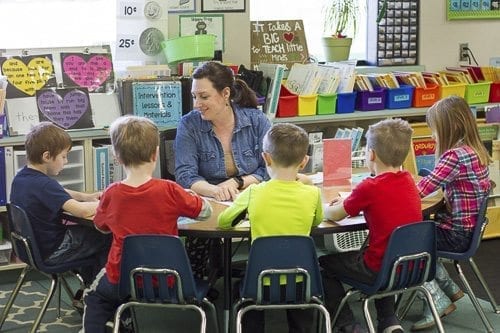Woodland Primary School uses a curriculum that motivates students to learn while playing at different teacher-designed stations
WOODLAND — Woodland Primary School uses Play-Based Learning, curriculum that motivates students to learn while playing at different teacher-designed stations, to internalize their lessons on a deeper level.
Studies show that five-year-old children can benefit from experiencing the world around them in additional to traditional classroom lessons.

“Kids, especially young students, make sense of their world through play – they need to ‘do’,” explained Ingrid Colvard, Woodland Primary School’s principal. “Instead of exclusively using traditional lessons to teach our students the skills they need to know, our teachers develop specific play-based curriculum to teach the skills students need to know in a way kids can better comprehend.”
For 45 minutes at the end of each school day, students take part in Play-Based Learning where they choose from a variety of different stations featuring different activities related to the lessons they learn in class.
“It takes very intentional planning for a teacher to have the materials, room arrangement, and structures in place to promote and support play-based learning,” explained Pat Jones, Woodland Primary’s instructional coach. “We seek a balance of child-initiated play, teacher-led activities, and experiential learning.”
Before beginning a new Play-Based Learning lesson, students are taught how each section works including what all the included items are as well as ground rules for behavior at each station. “You can’t make assumptions that all the kids will know about all the items at a section,” said Colvard. “We’ve had students take a computer mouse and try to run it directly on the monitor itself – you have to ensure every tool or toy you put in front of a student has been pre-taught.”

For example, Play-Based Learning Stations for reading and writing include:
- Working on reading using an overhead projector so students can write the words they see projected on a whiteboard to identify words by sight.
- A poetry station where students can read poetry about different topics ranging from Groundhog’s Day and losing a baby tooth to understanding rain clouds and why people like to read.
- Sight Word Booklets where students create a book of words covering a topic they choose.
- Word Toss where students play toss dice with words on them and have to select a word that rhymes with the word they read.
- Light Table where students create words using color-coded translucent magnetic letters on a table projecting a soft light.
Research studies support the effectiveness of Play-Based Learning.

“A Columbia University study found that play is vital for cognitive, social-emotional and physical growth in children,” said Jones. “When children play, they explore, problem-solve, take risks, make sense of their world, develop language, and engage in social negotiation.”
In addition to helping students internalize their lessons, Play-Based Learning promotes skills necessary to succeed in today’s job environment.
“Play-Based Learning promotes creativity and collaboration with your classmates,” explained Jones. “These attributes are highly-value in the 21st century workplace where colleagues are expected to work together as teams to achieve their goals.”
Woodland Primary fully implemented Play-Based Learning in the 2016-2017 school year when a shift in teacher placement offered a unique opportunity.
“We had four teachers new to Woodland Primary with three of them being brand-new to teaching any grade level,” said Colvard. “All four were incredibly supportive and felt Play-Based Learning resonated with them and their students so they took the state curriculum, adapted it to their classrooms, and we’re seeing huge progress in student learning and development.”
During one classroom visit, Principal Colvard noticed Kindergarten students sitting in a small group “playing school” with one student acting like the school principal. When the teacher asked the group, “You’re mathematicians, what made you into that?,” the students answered by explaining their lessons and what they learned. “The kids were just playing school, but by talking about mathematics and how they learned their lessons, they’re internalizing their learning,” explained Colvard. “The more learning becomes natural, the more powerful it becomes throughout a student’s entire academic career.”
In another classroom, students were sorting plastic horses.

“When they explained they were ‘sorting,’ we asked them to define the term and explain how sorting works,” said Jones. “The conversation progressed to talking about how scientists use sorting in experiments and how experiments actually work – concepts far beyond the lessons traditionally taught to Kindergarten students.”
While students engage in Play-Based Learning, teachers have the opportunity to provide additional instruction for students who may be struggling with specific lessons.
“By giving the students independence to learn on their own, I have the time to work one-on-one or with groups of students who may need help,” said Heather Cacak, a Kindergarten teacher at Woodland Primary. “Play-Based Learning just excellent because students develop so many skills at the same time which can also include socializing – an important skill for children to develop at a young age.”
In order to refine their techniques, teachers visit their colleagues’ classrooms in Learning Walks to find ideas about how other teachers approach the lessons.
“Having teachers watch one another really offers opportunities for them to evaluate and improve their own techniques,” explained Colvard. “Our teachers incredibly brave and transparent – they’re used to having people observe so it’s just become a normal part of daily teaching life.”
Information provided by Woodland Public Schools.




